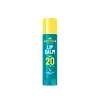What's inside
What's inside
 Key Ingredients
Key Ingredients

No key ingredients
 Benefits
Benefits

No benefits
 Concerns
Concerns

 Ingredients Side-by-side
Ingredients Side-by-side

Polyisobutene
Beeswax
Emulsion StabilisingHydrogenated Microcrystalline Wax
Emulsion StabilisingIsopropyl Myristate
EmollientCaprylic/Capric Triglyceride
MaskingStearyl Dimethicone
EmollientPolyethylene
AbrasiveOctyldodecanol
EmollientHomosalate
Skin ConditioningEthylhexyl Methoxycinnamate
UV AbsorberC26-28 Alkyl Dimethicone
Skin ConditioningEthylhexyl Salicylate
UV AbsorberButyl Methoxydibenzoylmethane
UV AbsorberParfum
MaskingPolyester-7
Skin ConditioningButyrospermum Parkii Butter
Skin ConditioningHelianthus Annuus Seed Oil
EmollientNeopentyl Glycol Diheptanoate
EmollientPhenoxyethanol
PreservativePetrolatum
EmollientBHT
AntioxidantTocopheryl Acetate
AntioxidantEthyl Ferulate
AntioxidantBisabolol
MaskingAscorbyl Tetraisopalmitate
AntioxidantIsohexadecane
EmollientTocopherol
AntioxidantRosmarinus Officinalis Leaf Extract
AntimicrobialEthylene/Propylene/Styrene Copolymer
Butylene/Ethylene/Styrene Copolymer
Xanthan Gum
EmulsifyingSodium Hyaluronate
HumectantTripeptide-1
Skin ConditioningPolyisobutene, Beeswax, Hydrogenated Microcrystalline Wax, Isopropyl Myristate, Caprylic/Capric Triglyceride, Stearyl Dimethicone, Polyethylene, Octyldodecanol, Homosalate, Ethylhexyl Methoxycinnamate, C26-28 Alkyl Dimethicone, Ethylhexyl Salicylate, Butyl Methoxydibenzoylmethane, Parfum, Polyester-7, Butyrospermum Parkii Butter, Helianthus Annuus Seed Oil, Neopentyl Glycol Diheptanoate, Phenoxyethanol, Petrolatum, BHT, Tocopheryl Acetate, Ethyl Ferulate, Bisabolol, Ascorbyl Tetraisopalmitate, Isohexadecane, Tocopherol, Rosmarinus Officinalis Leaf Extract, Ethylene/Propylene/Styrene Copolymer, Butylene/Ethylene/Styrene Copolymer, Xanthan Gum, Sodium Hyaluronate, Tripeptide-1
 Reviews
Reviews

Ingredients Explained
These ingredients are found in both products.
Ingredients higher up in an ingredient list are typically present in a larger amount.
Parfum is a catch-all term for an ingredient or more that is used to give a scent to products.
Also called "fragrance", this ingredient can be a blend of hundreds of chemicals or plant oils. This means every product with "fragrance" or "parfum" in the ingredients list is a different mixture.
For instance, Habanolide is a proprietary trade name for a specific aroma chemical. When used as a fragrance ingredient in cosmetics, most aroma chemicals fall under the broad labeling category of “FRAGRANCE” or “PARFUM” according to EU and US regulations.
The term 'parfum' or 'fragrance' is not regulated in many countries. In many cases, it is up to the brand to define this term.
For instance, many brands choose to label themselves as "fragrance-free" because they are not using synthetic fragrances. However, their products may still contain ingredients such as essential oils that are considered a fragrance by INCI standards.
One example is Calendula flower extract. Calendula is an essential oil that still imparts a scent or 'fragrance'.
Depending on the blend, the ingredients in the mixture can cause allergies and sensitivities on the skin. Some ingredients that are known EU allergens include linalool and citronellol.
Parfum can also be used to mask or cover an unpleasant scent.
The bottom line is: not all fragrances/parfum/ingredients are created equally. If you are worried about fragrances, we recommend taking a closer look at an ingredient. And of course, we always recommend speaking with a professional.
Learn more about ParfumPetrolatum is more commonly known as petroleum jelly. It is created by mixing waxes and mineral oils.
This ingredient is effective at reducing water loss by 99%. This is because it is an occlusive. Occlusives create a hydrophobic barrier on the skin to prevent evaporation. This property makes it great for hydrating dry skin.
Pro tip: Use occlusives, such as this ingredient, on damp skin for the best results.
The quality or origin of petrolatum is only known when disclosed by the brand. Most cosmetic petrolatum has gone through several purification stages.
Another benefit of occlusives is it protects your skin against infection or allergies.
Petrolatum may not be safe for fungal-acne. Studies show mineral oil / petroleum leads to the growth of M. Furfur, a type of yeast.
Learn more about Petrolatum